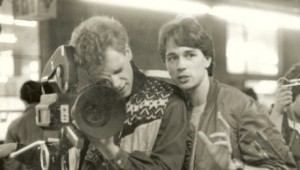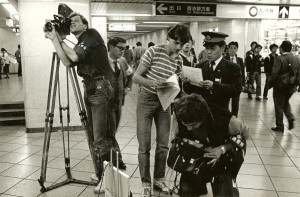[this part of the website is still under construction, please bear with us]
DIRECTING
 A film director is a person who directs the making of a film. Generally, a film director controls a film’s artistic and dramatic aspects, and visualizes the script while guiding the technical crew and actors in the fulfillment of that vision.[1] The director has a key role in choosing the cast members, production design, and the creative aspects of filmmaking.[2]
A film director is a person who directs the making of a film. Generally, a film director controls a film’s artistic and dramatic aspects, and visualizes the script while guiding the technical crew and actors in the fulfillment of that vision.[1] The director has a key role in choosing the cast members, production design, and the creative aspects of filmmaking.[2]
The film director gives direction to the cast and crew and creates an overall vision through which a film eventually becomes realized. Directors need to be able to mediate differences in creative visions and stay in the boundaries of the film’s budget. There are many pathways to becoming a film director. Some film directors started as screenwriters, cinematographers, film editors or actors. Other film directors have attended a film school. Directors use different approaches. Some outline a general plotline and let the actors improvise dialogue, while others control every aspect, and demand that the actors and crew follow instructions precisely. Some directors also write their own screenplays or collaborate on screenplays with long-standing writing partners. Some directors edit or appear in their films, or compose the music score for their films.
PRODUCTION
 In production, the video production/film is created and shot. More crew will be recruited at this stage, such as the property master, script supervisor, assistant directors, stills photographer, picture editor, and sound editors. These are just the most common roles in filmmaking; the production office will be free to create any unique blend of roles to suit the various responsibilities possible during the production of a film.
In production, the video production/film is created and shot. More crew will be recruited at this stage, such as the property master, script supervisor, assistant directors, stills photographer, picture editor, and sound editors. These are just the most common roles in filmmaking; the production office will be free to create any unique blend of roles to suit the various responsibilities possible during the production of a film.
A typical day’s shooting begins with the crew arriving on the set/location by their call time. Actors usually have their own separate call times. Since set construction, dressing and lighting can take many hours or even days, they are often set up in advance.
The grip, electric and production design crews are typically a step ahead of the camera and sound departments: for efficiency’s sake, while a scene is being filmed, they are already preparing the next one.
While the crew prepare their equipment, the actors are wardrobed in their costumes and attend the hair and make-up departments. The actors rehearse the script and blocking with the director, and the camera and sound crews rehearse with them and make final tweaks. Finally, the action is shot in as many takes as the director wishes. Most American productions follow a specific procedure.
LINE PRODUCTION
 The Line Producer supports the director’s vision and direct influence on the creative expression or narrative of the film,[4] though it could be argued that through a line producer’s ability to influence certain aspects of the film, like allocation of resources to certain departments, he or she can change important aspects of the film that have creative consequences, e.g Production Value. For example, they can affect the project’s look by influencing the choice of filming locations.[3] While the director is in charge of all purely artistic decisions, the line producer will help him or her to substantiate his or her creative ideas by taking care of logistics and related issues.[5] From pre-production through principal photography, the line producer oversees the production budget and physical needs of the shoot. By the first day of production, several versions of the budget will have usually been drafted. A finalized or “locked” budget is the one used as the basis for the production to move forward. A key objective of a line producer is to respect this “locked” budget and to deliver in time.
The Line Producer supports the director’s vision and direct influence on the creative expression or narrative of the film,[4] though it could be argued that through a line producer’s ability to influence certain aspects of the film, like allocation of resources to certain departments, he or she can change important aspects of the film that have creative consequences, e.g Production Value. For example, they can affect the project’s look by influencing the choice of filming locations.[3] While the director is in charge of all purely artistic decisions, the line producer will help him or her to substantiate his or her creative ideas by taking care of logistics and related issues.[5] From pre-production through principal photography, the line producer oversees the production budget and physical needs of the shoot. By the first day of production, several versions of the budget will have usually been drafted. A finalized or “locked” budget is the one used as the basis for the production to move forward. A key objective of a line producer is to respect this “locked” budget and to deliver in time.
While in production, the line producer oversees the execution of many decisions that must be made to deliver each day’s shoot. The administrative aspects, especially those that have any financial impact, are all crucial areas of the line producer’s work. These areas include but are not limited to negotiating compensation (usually during pre-production) of crew members (both for union and non-union productions) and resolving daily production issues (in conjunction with the first assistant director and possibly the unit production manager).[6] Moreover, they provide demanded equipment. If required they will handle unanticipated scheduling changes and serve “as a liaison between the crew and the producer”.[3]
DISTRIBUTION
 Film distribution is the process of making a movie available for viewing by an audience. This is normally the task of a professional film distributor, who would determine the marketing strategy for the film, the media by which a film is to be exhibited or made available for viewing, and who may set the release date and other matters. The film may be exhibited directly to the public either through a movie theater or television, or personal home viewing (including DVD-Video or Blu-ray Disc, video-on-demand, download, television programs through broadcast syndication etc.). For commercial projects, film distribution is usually accompanied by film promotion.
Film distribution is the process of making a movie available for viewing by an audience. This is normally the task of a professional film distributor, who would determine the marketing strategy for the film, the media by which a film is to be exhibited or made available for viewing, and who may set the release date and other matters. The film may be exhibited directly to the public either through a movie theater or television, or personal home viewing (including DVD-Video or Blu-ray Disc, video-on-demand, download, television programs through broadcast syndication etc.). For commercial projects, film distribution is usually accompanied by film promotion.
When a film is initially produced, a feature film is often shown to audiences in a movie theater. Typically, one film is the featured presentation (or feature film). Before the 1970s, there were “double features”; typically, a high quality “A picture” rented by an independent theater for a lump sum, and a “B picture” of lower quality rented for a percentage of the gross receipts. Today, the bulk of the material shown before the feature film consists of previews for upcoming movies (also known as trailers) and paid advertisements.
STILL PHOTOGRAPHY
 Photography is the science, art and practice of creating durable images by recording light or other electromagnetic radiation, either electronically by means of an image sensor, or chemically by means of a light-sensitive material such as photographic film.[1]
Photography is the science, art and practice of creating durable images by recording light or other electromagnetic radiation, either electronically by means of an image sensor, or chemically by means of a light-sensitive material such as photographic film.[1]
Typically, a lens is used to focus the light reflected or emitted from objects into a real image on the light-sensitive surface inside a camera during a timed exposure. With an electronic image sensor, this produces an electrical charge at each pixel, which is electronically processed and stored in a digital image file for subsequent display or processing. The result with photographic emulsion is an invisible latent image, which is later chemically “developed” into a visible image, either negative or positive depending on the purpose of the photographic material and the method of processing. A negative image on film is traditionally used to photographically create a positive image on a paper base, known as a print, either by using an enlarger or by contact printing.